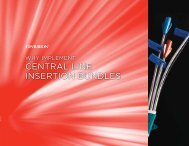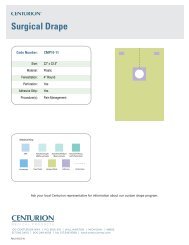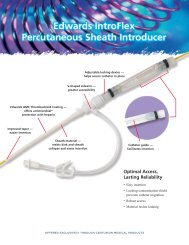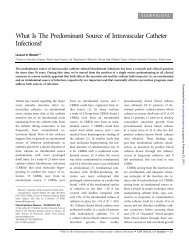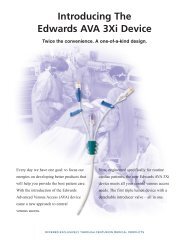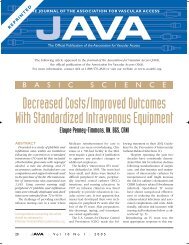Java SorbaView SHIELD Study
Java SorbaView SHIELD Study
Java SorbaView SHIELD Study
You also want an ePaper? Increase the reach of your titles
YUMPU automatically turns print PDFs into web optimized ePapers that Google loves.
V o l u m e 1 6 N u m b e r 2s u m m e r 2 0 1 164 Evidence-based Practice: Improving Outcomes for Patients with aCentral Venous Access DeviceDorothy Mathers, DNP, RN74 New Product Decisions - The Process and Outcome for a CommunityHealth SystemJose Delp, RN, BSN; Lynn Hadaway, M.Ed., RN, BC, CRNI86 The Ideal Use of the Power Injectable Peripherally Inserted CentralCatheter in the Pediatric PopulationStephanie Juanita Klee, BSN, RN95 Clinical Evaluation of the Sorbaview <strong>SHIELD</strong> Securement Device Used onPeripheral Intravenous Catheters in the Acute Care SettingPolly L. Flippo, RN, MSN, CMSRN, Jayne Lee, RN, MPH, CIC162
e s e a r c hs c h o l a r l yClinical Evaluation of the Sorbaview <strong>SHIELD</strong>Securement Device Used on Peripheral IntravenousCatheters in the Acute Care SettingPolly L. Flippo, RN, MSN, CMSRN, Jayne Lee, RN, MPH, CICAbstractPeripheral intravenous therapy (PIV) is probably the most common acute care invasive procedure, estimated at 90 percentfor all inpatients. Current standards of practice recommend the use of a manufactured catheter stabilization device tosecure PIVs. At FirstHealth Moore Regional Hospital (MRH), the PIV policy requires the use of a stabilization device toachieve a 96 hour dwell time for the PIV. The hospital does not utilize an intravenous therapy team; all nurses can insertPIVs and apply the dressing. In 2009, as a cost reduction measure, MRH changed securement devices from a two piecedressing and securement device to the Sorbaview <strong>SHIELD</strong> (<strong>SHIELD</strong>). A clinical evaluation of the <strong>SHIELD</strong> was conductedin January 2010, with 109 medical-surgical patients with PIVs, to demonstrate the expected cost savings associated withthe <strong>SHIELD</strong> by maintaining the PIV for 96 hours and meeting patient and staff expectations. In 91.5% of the patients, thePIV stayed in for their length of stay (if less than 96 hours) or for 96 hours, only eight patients had unscheduled restarts.Eighty-six percent of nurses surveyed rated the device as excellent to good. Ninety-one percent of patients reported nodiscomfort of their PIV site. Changing to this device in 2009 has resulted in an average annual cost savings of $120,000over the two piece device and has improved compliance by nursing.Correspondence concerning this article should be addressed topflippo@firsthealth.orgDOI: 10.2309/java.16-2-6BackgroundMajor forces affecting health care today include costcontainment, patient safety, and customer satisfaction.These forces impact not only major strategicdecisions but also those decisions which may appear at firstglance less significant, such as product selection for deliveringpatient care. Evidence based practice (EBP) is an approach thatgives clinicians the ability to provide a high quality of care tomeet the needs of their patients and often leads to cost savings(Melnyk & Fineout-Overholt, 2005).Intravenous therapy is probably the most common acute careinvasive procedure. It is estimated that at least 90 percent ofinpatients have a peripheral intravenous catheter (PIV) at somepoint in their stay (Hanchett, 2007). The Infusion Nurses Society(INS) Standards of Practice recommend the use of a manufacturedcatheter stabilization device (INS Standards, 2006).Studies have indicated that the use of a stabilization deviceincreases catheter dwell time, and decreases the incidence ofphlebitis, infiltration, and infection which are the most commoncomplications of PIV therapy and are reported by patientsto cause significant discomfort and pain. A number of companiesincluding BARD, Baxter, and Centurion all manufacturestabilization devices.A study of the BARD StatLock (StatLock) stabilizing deviceon 10,164 patients conducted by Dr. Gregory Shears indicatedthat in a 300 bed hospital, annual cost savings of $277,000could be realized by using a stabilizing device on peripheralintravenous catheters (Shears, 2006). Studies conducted usingCenturion’s <strong>SorbaView</strong> devices have shown similar resultsin terms of potential cost savings due to increased dwell timeand decreased rates of complications (McNeill et al 2009; Penney-Timmons,2005). FirstHealth Moore Regional Hospital’s(MRH) policy on peripheral PIV therapy states that if a stabilizationdevice is used, the PIV catheter must be changed every96 hours. If a stabilization device in not used, the PIV cathetermust be changed every 72 hours. MRH does not use an intravenoustherapy team; all nurses can insert PIVs and apply thedressing. Nurses who work on inpatient units are required touse a securement device when starting PIVs.In 2009, MRH changed securement devices from the Stat-Lock device and a dressing to the integrated securement device,the Sorbaview <strong>SHIELD</strong> (<strong>SHIELD</strong>) as a part of cost reductionmeasures that were put into place. As with any change, some | JAVA | Vol 16 No 2 | 2011
Figure 1. Sorbaview <strong>SHIELD</strong> SV254Figure 2. Custom IV Start Kitnurses liked the “old” StatLock and some preferred the “new”<strong>SHIELD</strong> devices. Nurses began to ask, is one device better thanthe other in terms of length of dwell time? If the <strong>SHIELD</strong> costsless but doesn’t result in a dwell time of 96 hours, is it reallysaving MRH money? To improve compliance with the <strong>SHIELD</strong>device by all nurses, we decided to evaluate the performance ofthe <strong>SHIELD</strong> and observe a minimum of 50 PIV sites to determineif in fact it was securing the PIV for 96 hours.The purpose of this project was to determine if PIVs securedwith the <strong>SHIELD</strong> stayed in place for 96 hours and to collectinformation on patients’ perception of comfort of the PIV site,and nurses’ rating of the <strong>SorbaView</strong> <strong>SHIELD</strong> in terms of easeof application, ability to view the PIV site, and reliability. Theevaluation was conducted in January 2009 in three phases thatincluded 85 nurses on three medical/neurological acute careunits and 109 patients.Phase IThis phase consisted of reeducation and training of all nurseswho worked on the participating units on the proper applicationof the <strong>SHIELD</strong> by Centurion educators prior to the start of datacollection to assure all nurses were using the product correctly.The <strong>SHIELD</strong> had been in use for approximately six months priorto Phase I. During this phase, 85 nurses on the participating unitsalso completed a short anonymous survey rating the <strong>SHIELD</strong>.The survey was based on a tool used by McNeill et al (2009) onthe Sorbaview 2000 dressing and simply asked nurses to rate the<strong>SHIELD</strong> based on four performance characteristics (Table 1).Table 1. Nurses Rating of <strong>SHIELD</strong>Based on your current experience, please rate the Sorbaview<strong>SHIELD</strong> based on the following criteria:MethodsMaterialsThe securement device we evaluated was the Sorbaview<strong>SHIELD</strong> SV254 (Centurion Medical Products Corporation),which is shown in Figures 1 and 2. The <strong>SHIELD</strong> combines thedressing and securement system in one-piece, which providesfor a one step application process.Design and ProceduresThis project was designed to be a clinical evaluation of the<strong>SHIELD</strong>. Data was collected on a convenience sample of inpatientswith PIV catheters on three medical/neurological acutecare units at MRH, a 385-bed, non-profit acute care hospital incentral North Carolina. The units, 2 Neurology, 3 Medical and4 Medical, were chosen based on their high use of peripheralintravenous catheters and patients’ length of stay.Easy to applyKept IV sterile and secureAbility to visualize IV siteReliabilityComments:Excellent Good Average Fair Poor2011 | Vol 16 No 2 | JAVA |
Table 2. Data Collection ToolDay 1 Day 2 Day 3 Day 4Participant ID #Room # /Last NameDate/Time IV StartedIV Site Location/GaugeDay 1: Date & Time ofObservation/Description of SitePatients rating of discomfort (0-5); 0= nodiscomfort 5=lots of discomfortDay 2: Date & Time ofObservation/Description of SitePatients rating of discomfort (0-5); 0= nodiscomfort 5=lots of discomfortDay 3: Date & Time ofObservation/ription of SiteDescPatients rating of discomfort (0-5); 0= nodiscomfort 5=lots of discomfortDay 4: Date & Time ofObservation/Description of SitePatients rating of discomfort (0-5); 0=nodiscomfort 5=lots of discomfortTOTAL DWELL TIMEIV SITE OBSERVATIONSWNL dry/intact/ no redness/ no painD/C'd scheduled D/CUSRunscheduledrestart (indicate reason) ______**a. Dislodgement b. Catheter leaking c. Infiltration d. Infectione. Phlebitis f. Pain/discomfort g. Pt request h. Other (list on back of form)ID#Reason for USR** When IV restarted either a scheduled restartor USR, start a new entry for the patientAbbreviation Key: ID – identification, WNL – within normal limitsD/C’d – discontinued, USR – unscheduled restarts | JAVA | Vol 16 No 2 | 2011
Figure 3. Reasons for Unscheduled Starts35%30%25%20%15%DislodgementLeakingInfiltrationInfectionPhlebitisPain/discomfortPatient requestOther-occlusionInfiltratedReason not documented10%5%0%2 3 0 0 0 0 0 1 1 1Phase IIAt the completion of Phase I, data was collected on the threeunits using a self developed tool to evaluate dwell time, unscheduledrestarts, PIV anatomical site, and patients’ rating of comfortof the PIV site (Table 2). Data on the location of the PIV andgauge of needle were collected to determine if location and sizemade a difference in the dwell time of the PIV. (Tables 5 and 6)To minimize bias and increase reliability of the data collected,IVECON Training, Inc., a company which provides education andtraining to nurses on infusion therapy, was contracted by Centurionto provide a registered nurse (RN) to collect data, observe patients’PIV sites and record the information on the data collectiontool. (Hereafter known as the project support nurse). The projectsupport nurse was trained by the authors to complete the data collectiontool and was vetted and granted appropriate privileges tocollect data per current MRH and FirstHealth policies.Patients were followed for 96 hours or until the end of PIVtherapy if less than 96 hours. Patients who were admitted whosePIVs were started in another department had to have the <strong>SHIELD</strong>applied to their PIV site by their primary nurse on admission toTable 3. Dwell TimeDwell Time IV Count %Total IV’s Started on study units 94 100%Stayed in until IV D/C’d (LOS/TX < 96 hrs) 58 61.7%Stayed in for 96 hrs. 28 29.8%Stayed in for LOS/TX or 96 hrs 86 91.5%Unscheduled restarts 8 8.5%Abbreviation Key: IV – intravenous sites, D/C’d – discontinued,Hrs – hours, LOS/TX – length of stay or PIV therapythe unit to be included in the evaluation. During the evaluationperiod, the project support nurse completed the data collectiontools, and the primary nurse of the patients documented theirassessments of the sites in the patients’ medical record per theirusual practice. If there were any sites assessed with possiblecomplications by the project support nurse, she verified her assessmentof the PIV site with the patient’s primary nurse.Phase IIIAt the conclusion of data collection, a final survey of nurseson the participating units was conducted on their rating of the<strong>SHIELD</strong> based on the same performance characteristics usedin Phase I to determine if their rating of the product would improvewith more intense training (Table 1).Subjects Consent and Protection of Patients’ RightsThe project was presented to the Sandhills Multi-InstitutionalReview Board (SMIRB). Upon review, the SMIRB determinedthat because the use of the <strong>SHIELD</strong> was not a new intervention(and therefore classified the clinical evaluation as a qualityimprovement project of an existing product in use) and becausethe risk to privacy and confidentiality was considered minimal,the proposal was exempt from full review by the SMIRB.The following precautions were taken to maintain privacy andconfidentiality: as part of the vetting process, the project supportnurse was asked to sign a patient confidentiality agreement;patients who participated were de-identified by being assigneda participant number by the authors and no identifying informationsuch as name was kept on file that could link data collectedto specific patients; the project support nurse did not have accessto patients’ medical records; data was reported in aggregate formonly and could not be traced back to individual patients. Theevaluation took only 5-10 minutes of patients’ time and involveda brief visual inspection of the PIV site and required patients toverbally rate the comfort level of their PIV site.2011 | Vol 16 No 2 | JAVA |
Table 4. Nurses’ Rating of the <strong>SHIELD</strong> Pre- and Post-EvaluationExcellent Excellent Good Good Avg Avg Fair Fair Poor PoorPre-Eval Post-Eval Pre-Eval Post-Eval Pre-Eval Post-Eval Pre-Eval Post-Eval Pre-Eval Post-EvalEasy to apply 61% 56% 25% 37% 13% 7% 0% 0% 1% 0%Kept IV sterile 58% 52% 24% 26% 8% 15% 7% 7% 3% 0%Able to visualize site 71% 59% 20% 37% 6% 4% 3% 0% 0% 0%Reliable 56% 45% 24% 33% 11% 11% 6% 11% 3% 0%Overall rating 62% 53% 23% 33% 10% 9% 4% 5% 2% 0%Abbreviation Key: Eval=EvaluationVerbal consent was obtained by the project support nurse uponthe first contact with the patient. Obtaining written informedconsent would have identified the patients who participated inthe evaluation of the <strong>SHIELD</strong>. The project support nurse reada brief script and obtained the verbal consent of patients toobserve their PIV site and answer the question about comfortof the PIV site. All patients on the participating units receivedthe same standard PIV care per MRH policy and there was nochange in treatment or standard of care as a result of the study.Data AnalysisDwell time, restart rate, complication rates, patients’ ratingof comfort of site, and nurses rating of the <strong>SHIELD</strong> were tabulatedusing descriptive statistics.ResultsDwell TimeA total of 109 patients with PIVs were available for observationon the participating units during Phase II, which exceededthe minimum goal to observe 50 patients with PIVs. Dwelltime, unscheduled restarts, patients’ rating of comfort of site,and nurses’ rating of the <strong>SHIELD</strong> were evaluated. Of the 109patients followed, 15 were eliminated from the evaluation becausetheir PIV’s were started by nurses on non -participatingunits and were not changed on arrival to the units participatingin the evaluation. Eighty-six of the remaining 94 PIVs (91.5%)stayed in for the patient’s length of stay or for 96 hours. Therewere eight unscheduled restarts. (Table 3)A breakdown of unscheduled restarts is detailed in Figure 3.The data on this table is notable for what is not included as areason for an unscheduled restarts, namely phlebitis and infection.No phlebitis was observed in the 94 patients in this study.Phlebitis rates of 3.6% with tape dressings and 0.7% with astabilization device were previously reported by Shears in hisstudy of 10,164 patients (Shears, 2006).Patient Rating of Discomfort of PIV SiteDuring each observation of their PIV site, patients wereasked to rate the comfort of their site on a scale of 0 –5 (0=no discomfort; 5= lots of discomfort). The majority of patients(91%) responded that they experience no discomfort (0), only1% of patients experienced lots of discomfort (5), and 8% ofpatients were non-verbal and unable to respond (Figure 4).Nurses’ Rating of the <strong>SHIELD</strong>Nurses were asked to rate the <strong>SHIELD</strong> pre- and post-evaluationregarding its ease of application, ability to keep the PIV sterile,reliability, and the ability to visualize the PIV site with the<strong>SHIELD</strong> in place. Table 4 describes nurses’ rating of the <strong>SHIELD</strong>pre and post evaluation. When rating the overall performance ofthe Shield, 86% of nurses rated it as good to excellent.DiscussionFollowing our clinical evaluation an analysis of data suggeststhat the <strong>SHIELD</strong> is a very reliable and effective device in thatthese results were obtained as nurses used a variety of sites forthe location of the PIV, from the most vulnerable securementlocations to the typically least troublesome and with both smalland large gauge catheters. (Tables 5 & 6) Even though we didnot compare the <strong>SHIELD</strong> to any other securement devices anddo not know how patients would have rated those devices, itwas an additional positive that the majority of patients rated thediscomfort of their PIV site when secured with the <strong>SHIELD</strong> as“0=no discomfort”.Table 5.Location of IV SitesLocation of IV SitesForearm 31%Wrist 23%Antecubital 20%Hand 19%Other 4%Shoulder 2%Foot 1%Table 6. Breakdown ofCatheter Gauge UsedCatheter Gauge Used20 47%22 33%18 13%24 5%Not Documented 2% | JAVA | Vol 16 No 2 | 2011
Figure 4. Patients’ Rating of Discomfort of PIV Site100%90%80%70%60%91%LEGEND0 = None5 = LotsNV = Non verbal50%40%30%20%10%0%0% 0% 0% 0% 1%0 1 2 3 4 58%NVAlthough there was not a considerable difference in nurses’rating of the <strong>SHIELD</strong> pre and post study, the data was still veryvaluable. First and foremost it illustrated the importance of havingnurses perform a return demonstration of correct applicationof the Shield. Prior to changing to the Shield, Centurionprovided “walking rounds” where sales staff visited each unitand demonstrated how to apply the Shield, a return demonstrationwas not part of the “walking rounds.” As the Centurioneducator was conducting the pre-evaluation training, it becameapparent that not all nurses were applying the <strong>SHIELD</strong> properly.MRH’s clinical educators have collaborated with Centurionand developed a timetable to reeducate nurses who were not onthe participating units on the correct application of the Shield,which will include a return demonstration. The survey of nursesalso served to validate and quantify their level of satisfactionwith the <strong>SHIELD</strong> rather than relying on anecdotal reports.This evaluation also identified a need to improve documentationof PIV therapy throughout the hospital. Nurses on unitsroutinely document the PIV site, gauge, and if the PIV is intact,however when a PIV is discontinued or restarted, the reason isseldom documented. In the emergency department (ED), nursesrarely document that a PIV has been started. When reviewingED documentation, it was not unusual to find a physician’sorder for a PIV and nursing documentation that the patient hadreceived “X” amount of IV fluid, but there was hardly everdocumentation that the PIV was actually started, let alone documentationof the site and gauge.The use of the Sorbaview <strong>SHIELD</strong>, can improve patient safetyby reducing unscheduled restarts as evidenced by only eightpatients requiring unscheduled restarts and the fact that none ofthe restarts were due to phlebitis or infection. Safety for nursesis likely improved as well by reducing the exposure they haveto PIV restart needles. Statistics on needle sticks indicate that onaverage discontinuing and starting PIVs accounts for 3% -9 %of needle sticks in institutions (NIOSH, 1999).Initially the change to the <strong>SHIELD</strong> at MRH was initiated toreduce the cost of the PIV dressings and securement devices.One of our goals was to determine if changing to the Sorbaview<strong>SHIELD</strong> as a cost savings measure was indeed saving MRHmoney. If PIVs were lasting for 96 hours with the <strong>SHIELD</strong>then fewer restarts and materials were needed. According toour Materials Management Department, for fiscal year 2009,the estimated annual materials savings in terms of the directcost of the <strong>SHIELD</strong> has been $120,000. A very high percentage(91%) of PIVs secured with the <strong>SHIELD</strong> had a dwell time ofout to 96 hours and the restart rate was only 9%. This is consistentwith results of other studies on other securement devices(McMahon, 2002 and Royer, 2003). Not calculated into the estimatedcosts savings is the money being saved by not having torestart PIVs as frequently which includes those intangible costssuch as decreased complication rates for patients and nursingtime savings by reducing restarts. Based on average salary andbenefits for an RN, the average time of 36 minutes for a nurseto trouble shoot and restart a PIV translates to a labor cost of anestimated $22.79 per incident (Rosenthal, 2005).This evaluation had several limitations. First, there was nobaseline data collected on dwell time and restart rates beforeuse of the <strong>SHIELD</strong>, therefore it was not possible to quantify theimprovement in dwell time and reduction in restart rates withthe use of the <strong>SHIELD</strong>. A second limitation is that data was notcollected on whether the PIV catheter was connected to a salinelock or a continuous infusion. Even though the restart rate wasonly 9%, the type of PIV (saline lock or continuous) may havean effect on dwell time. Finally, a third limitation is the scopeof the project. The purpose was to evaluate performance of the<strong>SHIELD</strong> and staff’s satisfaction with it. It was not poweredor designed for statistical comparisons which limit the conclusionsthat can be made.2011 | Vol 16 No 2 | JAVA |
ConclusionThe purpose of this clinical evaluation was to determine ifPIVs secured with the <strong>SHIELD</strong> stayed in place for 96 hours andto determine patients’ perceptions of the comfort of the <strong>SHIELD</strong>,and nurse satisfaction with the product. The <strong>SHIELD</strong> productwas found in this evaluation to last out to 96 hours or until thePIV was discontinued in 91% of patients followed. There wereeight patients that required restarts none of which were relatedto phlebitis or infection. The <strong>SHIELD</strong> is less expensive thanother securement devices on the market and 86% of nurses aresatisfied with its performance. The majority of patients had nodiscomfort at the PIV site. MRH has determined to continue theuse of the <strong>SHIELD</strong>. Opportunities for reeducation of nurses onthe proper application of the <strong>SHIELD</strong> and evaluation of nurses’documentation of IV therapy were identified.AcknowledgementsMaterials and in-service/training was provided by CenturionMedical Products Corp (CMPC), Williamston, MI. IVECONTRAINING INC was used as an outside, paid independentsubcontractor of CMPC for some nurse training, data collection,and in-service associated with the clinical evaluation ofthe Sorbaview <strong>SHIELD</strong>.ReferencesHanchett, M. (2004). ICT: Visualizing the IV fluid path: Emergingconcept in infection control. Infection Control Today. Retrieved11/10/2009 from http://www.infectioncontroltoday.com.Infusion Nursing Society. (2006). Infusion nursing standardsof practice. Infusion Nursing Society.McMahon, D. (2002). Evaluating new technology to improvepatient outcomes: A Quality Improvement Approach. Journalof Infusion Nursing. 24(4). 250-255.McNeill, E. E., Hines, N. L., & Phariss, R. (2009). A clinicaltrial of a new all-in-one peripheral-short catheter. Journal ofthe Association of Vascular Access. 14(1). 46-51.Melnyk, B.M., & Fineout-Overholt, E. (2005). Evidence-basedpractice in nursing and healthcare. A guide to best practice.Philadelphia. Lippincott Williams & Wilkins.NIOSH: National Institute for Occupational Safety and Health.(1999). Preventing Needlestick Injuries in Health Care Settings.(DHHS Publication No. 2000-108 {Alert}),Washington, DC: U.S. Government Printing Office.Penney-Timmons, E.P. (2005). Decreased costs/improved outcomeswith standardized intravenous equipment. Journal ofthe Association of Vascular Access. 10(1). 20-23.Rosenthal, K. (2005). Get a hold on costs and safety with securementdevices. Nursing Management. 36(5). 52-53.Royer, T. (2003). Improving short peripheral I.V. outcomes: Aclinical trial of two securement methods. Journal of the Associationof Vascular Access. 8(4). 1-5.Shears, G.J. (2006). Summary of Product Trials for 10,614 patients:Comparing an intravenous stabilizing device to tape.Journal of Infusion Nursing. 29(4). 225-231.LIT160V1 | JAVA | Vol 16 No 2 | 2011



